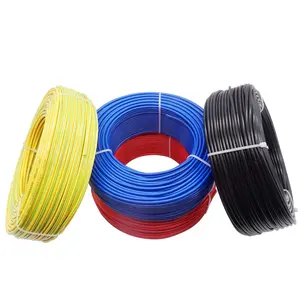
All categories
Featured selections
Trade Assurance
Buyer Central
Help Center
Get the app
Become a supplier














Tại Alibaba.com, có một bộ sưu tập khổng lồ những điều kỳ diệu. dây điện 4mm bạn có thể chọn và sử dụng trong công việc của mình. Tính linh hoạt của. dây điện 4mm làm cho chúng trở thành một lựa chọn tuyệt vời trong nhiều công trình xây dựng và mộc. Chúng được sử dụng rộng rãi trong các công trình kết cấu, ngoại thất và nội thất, nơi chúng tạo ra những kết quả vượt trội. Để phù hợp với nhiệm vụ cụ thể, thích hợp. dây điện 4mm phải có một số tính năng nhất định phù hợp với những tác vụ đó.
Những tính năng này. dây điện 4mm được đặc trưng bởi độ ổn định cao hơn và khả năng chống va đập cao hơn. Thuộc tính này cung cấp cho họ khả năng đáp ứng tình trạng quá tải ở một mức độ nhất định. Những cái này. dây điện 4mm cung cấp tỷ lệ độ bền và độ cứng so với trọng lượng cao đáng kể. Khả năng chống lại hóa chất và ăn mòn vượt trội làm cho. dây điện 4mm có độ bền cao, đặc biệt khi được xử lý bằng chất bảo quản. Do đó, bạn có thể sử dụng chúng trong nhiều lĩnh vực trong nhà, công nghiệp hoặc văn phòng của mình và nhận được những kết quả ấn tượng.
Với sự lựa chọn đa dạng. dây điện 4mm tại Alibaba.com, bạn sẽ tìm thấy lựa chọn lý tưởng của mình. Chúng có tính linh hoạt và khả năng uốn cong vô song cùng với một loạt các độ dày giúp mở rộng khả năng sử dụng của chúng trong các lĩnh vực khác nhau. Các biện pháp phòng ngừa đã được thực hiện để thực hiện. dây điện 4mm chống cháy bằng cách sử dụng các lớp phủ chống cháy và kết hợp chúng với các vật liệu khó cháy. Các đặc tính cách nhiệt và cách âm của chúng. dây điện 4mm đảm bảo chúng cung cấp một môi trường thoải mái khi được sử dụng trong xây dựng.
Hãy tận hưởng tất cả những lợi ích này với các giao dịch tuyệt vời tại Alibaba.com. Khám phá trang web và khám phá tuyệt vời. dây điện 4mm phạm vi và chọn những thứ tốt nhất cho bạn .. dây điện 4mm người bán và nhà cung cấp cũng có thể so sánh các đề nghị khác nhau và giải quyết các tùy chọn phù hợp nhất. Với chất lượng và kết quả hiệu quả, bạn sẽ nhận ra rằng tiền của bạn đã được chi tiêu hợp lý.